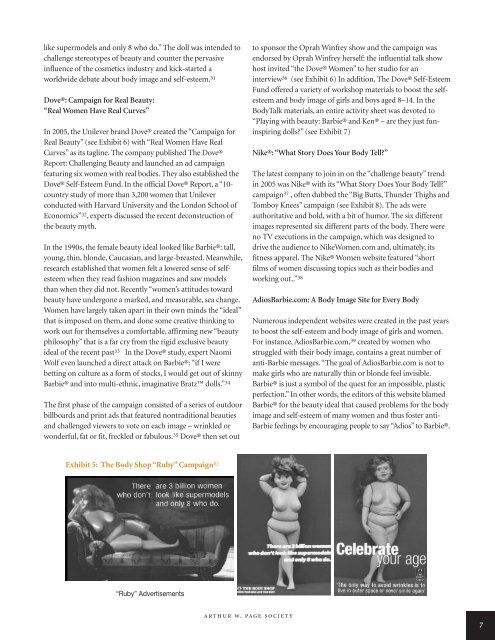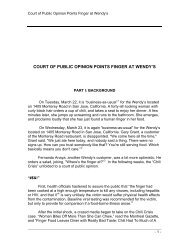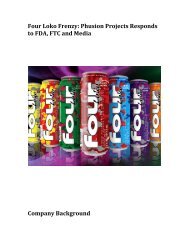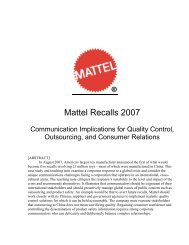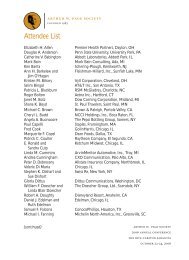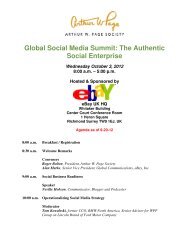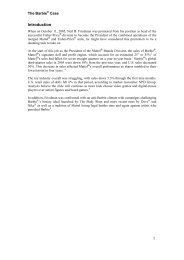The Barbie Case - The Arthur Page Society
The Barbie Case - The Arthur Page Society
The Barbie Case - The Arthur Page Society
Create successful ePaper yourself
Turn your PDF publications into a flip-book with our unique Google optimized e-Paper software.
like supermodels and only 8 who do.” <strong>The</strong> doll was intended to<br />
challenge stereotypes of beauty and counter the pervasive<br />
influence of the cosmetics industry and kick-started a<br />
worldwide debate about body image and self-esteem. 31<br />
Dove®: Campaign for Real Beauty:<br />
“Real Women Have Real Curves”<br />
In 2005, the Unilever brand Dove® created the “Campaign for<br />
Real Beauty” (see Exhibit 6) with “Real Women Have Real<br />
Curves” as its tagline. <strong>The</strong> company published <strong>The</strong> Dove®<br />
Report: Challenging Beauty and launched an ad campaign<br />
featuring six women with real bodies. <strong>The</strong>y also established the<br />
Dove® Self-Esteem Fund. In the official Dove® Report, a “10country<br />
study of more than 3,200 women that Unilever<br />
conducted with Harvard University and the London School of<br />
Economics” 32,experts discussed the recent deconstruction of<br />
the beauty myth.<br />
In the 1990s, the female beauty ideal looked like <strong>Barbie</strong>®: tall,<br />
young, thin, blonde, Caucasian, and large-breasted. Meanwhile,<br />
research established that women felt a lowered sense of selfesteem<br />
when they read fashion magazines and saw models<br />
than when they did not. Recently “women’s attitudes toward<br />
beauty have undergone a marked, and measurable, sea change.<br />
Women have largely taken apart in their own minds the “ideal”<br />
that is imposed on them, and done some creative thinking to<br />
work out for themselves a comfortable, affirming new “beauty<br />
philosophy” that is a far cry from the rigid exclusive beauty<br />
ideal of the recent past 33 In the Dove® study, expert Naomi<br />
Wolf even launched a direct attack on <strong>Barbie</strong>®: “if I were<br />
betting on culture as a form of stocks, I would get out of skinny<br />
<strong>Barbie</strong>® and into multi-ethnic, imaginative Bratz dolls.” 34<br />
<strong>The</strong> first phase of the campaign consisted of a series of outdoor<br />
billboards and print ads that featured nontraditional beauties<br />
and challenged viewers to vote on each image – wrinkled or<br />
wonderful, fat or fit, freckled or fabulous. 35 Dove® then set out<br />
Exhibit 5: <strong>The</strong> Body Shop “Ruby” Campaign 82<br />
“Ruby” Advertisements<br />
arthur w. page society<br />
to sponsor the Oprah Winfrey show and the campaign was<br />
endorsed by Oprah Winfrey herself: the influential talk show<br />
host invited “the Dove® Women” to her studio for an<br />
interview 36 (see Exhibit 6) In addition, <strong>The</strong> Dove® Self-Esteem<br />
Fund offered a variety of workshop materials to boost the selfesteem<br />
and body image of girls and boys aged 8–14. In the<br />
BodyTalk materials, an entire activity sheet was devoted to<br />
“Playing with beauty: <strong>Barbie</strong>® and Ken® – are they just funinspiring<br />
dolls?” (see Exhibit 7)<br />
Nike®: “What Story Does Your Body Tell?”<br />
<strong>The</strong> latest company to join in on the “challenge beauty” trend<br />
in 2005 was Nike® with its “What Story Does Your Body Tell?”<br />
campaign 37 ,often dubbed the “Big Butts, Thunder Thighs and<br />
Tomboy Knees” campaign (see Exhibit 8). <strong>The</strong> ads were<br />
authoritative and bold, with a bit of humor. <strong>The</strong> six different<br />
images represented six different parts of the body. <strong>The</strong>re were<br />
no TV executions in the campaign, which was designed to<br />
drive the audience to NikeWomen.com and, ultimately, its<br />
fitness apparel. <strong>The</strong> Nike® Women website featured “short<br />
films of women discussing topics such as their bodies and<br />
working out..” 38<br />
Adios<strong>Barbie</strong>.com: A Body Image Site for Every Body<br />
Numerous independent websites were created in the past years<br />
to boost the self-esteem and body image of girls and women.<br />
For instance, Adios<strong>Barbie</strong>.com, 39 created by women who<br />
struggled with their body image, contains a great number of<br />
anti-<strong>Barbie</strong> messages. “<strong>The</strong> goal of Adios<strong>Barbie</strong>.com is not to<br />
make girls who are naturally thin or blonde feel invisible.<br />
<strong>Barbie</strong>® is just a symbol of the quest for an impossible, plastic<br />
perfection.” In other words, the editors of this website blamed<br />
<strong>Barbie</strong>® for the beauty ideal that caused problems for the body<br />
image and self-esteem of many women and thus foster anti-<br />
<strong>Barbie</strong> feelings by encouraging people to say “Adios” to <strong>Barbie</strong>®.<br />
7


